Following the conventions of a film poster, I looked at the conventions of the poster titles, taglines and image to begin the layout. Below is a few images of examples of layout I have an idea for.
I used the photo editing program 'G.I.M.P' to create a draft of a poster based on one of the layouts above. To do this, I used a screen-cap from one of our scenes which fit as the main image as it provided room for a title to fit to the side and frame the image itself. Whilst the tagline is not short like the general drama film poster is, I think that as a start the tagline incorporates what is in the film, showing that in involves memories/forgetting.
In this design, I wanted the tagline and the title to be clear and eye catching, so when editing I used the 'Drop Shadow' tool to create the effect of shadow behind the text. Also with the title I used a tool on the program called 'Blinds' to create the effect of the title bring broken up as earlier in my project, [Post 3], when looking at the characterisation of the antagonist, there was an image where someone had been split up into sections and I felt that this worked with the title of our film.
However, I have noticed that the tagline is what stands out the most and in the final poster design I will edit this.
Sunday, 24 November 2013
Saturday, 23 November 2013
Post 33 - Drama Genre Posters [Specific to my Genre]
For example, I have looked at a drama film poster on the right, '127 Hours', and I notice that the layout is very empty, the main image is that of a canyon which frames the figure and boulder in the middle of the poster. The title and tagline are also framed by the image, the near symmetry of the canyon almost trapping the text inside.
The colours in this poster are something which I also noticed, the figure and the canyon are shrouded in shadow creating an atmosphere for the drama genre; whilst the sunset in the background alludes to the title. The text of the entire poster matches the sunset, the top being brighter than that bottom, except for the tagline 'Every Second Counts', which is white against a burgundy background, this contrast makes it very clear and whilst the text is small, it also is very clear and noticeable. The tagline itself is shot and straight to the point.
In comparison, I looked at the difference between the dramatic '127 Hours' poster and a 'Airplane' comedy poster.
Comedy film posters appear to have the convention of being bold and bright and 'in your face', to capture the audience's attention.
Drama film posters appear to use a single image with a contrast somewhere in the poster to catch the eye of the audience.
I looked into some other drama film posters to look at similarities within the genre and it's sub-genres. [L-R: Becoming Jane, The Show Must Go On, Black Swan]
First off, all three posters are character and image driven, all three consist of one large photo which takes up the majority of the poster, with Becoming Jane containing two. They also have the title towards the bottom of the poster, like '127 Hours' did too. I think that this is done as it creates a framing for the image and makes the image the key focus. Also only the middle on contains a tagline, which is to the side of the image, whilst the other two are versions of the poster which do not contain a tagline. Becoming Jane uses a divide between the two images to bring importance to the title, whilst the other two use contrast of white and black to make it clear and obvious.
Post 32a - Film Posters [Media Theory]
 Ronald Barthes' Media Theory
Ronald Barthes' Media Theory
Ronald Barthes was a French theorist and semiologist and through his work of deciphering works were 'put together' there are 5 narrative codes within media which apply to posters.
- Action Code - Little actions which do not raise questions, used to build tension and suspense to an audience what is going to happen, and to entice them to guess.
- Enigma Code - An element which is not explained and acts as a mystery to get the audience involved and raise questions.
- Referential Code - Refers to an external [cultural, scientific or historical] body of knowledge.
- Symbolic Code - Looks at symbols and their connotations and the meanings behind them.
- Semantic Code - An aspect which suggests or refers to additional meaning.
He suggested that narratives are split into two, OPEN and CLOSED. OPEN is when a narrative can be unravelled in multiple different ways and they way it can be viewed can be different. CLOSED is when there is only one obvious way to interpret something.
Post 32 - Film Posters
The main reason film marketers produce posters is to promote the film, thus the poster it required to follow some conventions to fit this demand. A poster must be eye catching, posters can be displayed at cinemas, on billboards, on a bus stop, train station platforms etc, anywhere as they can be designed to fit any shape.
If a film poster was not eye catching in these locations then it would fail. A poster should be designed to be easily noticed and something people will look at as they go past it [or it goes past them], and thus there are features in a poster which capture the eye of an audience, this is usually one of the below.
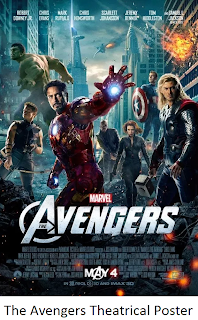 Character Posters - Multiple versions of a poster which contain one or two characters in the film, often is done to promote the actor.
Character Posters - Multiple versions of a poster which contain one or two characters in the film, often is done to promote the actor.
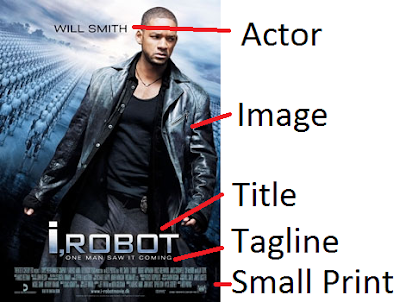
If a film poster was not eye catching in these locations then it would fail. A poster should be designed to be easily noticed and something people will look at as they go past it [or it goes past them], and thus there are features in a poster which capture the eye of an audience, this is usually one of the below.
- A large centrally positioned photo of the main character/s
- Large bold font with the title/log-line.
TYPES OF FILM POSTERS
 Character Posters - Multiple versions of a poster which contain one or two characters in the film, often is done to promote the actor.
Character Posters - Multiple versions of a poster which contain one or two characters in the film, often is done to promote the actor.
Teaser Poster - Usually will contain a main character and a release date, doesn't really contain much that reveals aspects of the film and rather is used to entice the audience to look it up.
Theatrical Poster - Is released with the film, this will usually contain all the main characters [either a group or the single main one] but will also include information on the production companies, actors, director, and title. Along with the release date and rating. Can also include reviews.
DVD Poster - Released alongside with the DVD release, will be the same poster as the theatrical but will include more reviews.
Main Features of a Poster

Post 31 - PRE-PRODUCTION: Crew List
Below is a list of jobs and the group members who preformed each job:
- Director - Myself
- Camera - Sabene and myself [at times]
- Lighting - Hannah [And Charlie when required]
- Production - Myself, Hannah and Sabene
- Editing - Myself
- Art Department - Myself
- Costume/Make-up - Sabene, Charlie, Hannah and myself.
- General Organiser - Myself [And Sabene when required]
- Pre-production - Sabene, Myself, Hannah and Charlie
When decided who would do what, each of us discussed what our strengths and weaknesses were and we split the jobs up between us to match them to our strengths.
Post 30 - PRE-PRODUCTION: Shooting Schedule
When doing our shooting schedule, I worked with my group to order the shots with lighting in mind. As we are filming in the winter, we have to make sure we film the early morning shots which require a lot of light, towards the start of filming so that we have enough light. We also worked through the shot list to make the schedule, keeping in mind when our group was available to film and the timing of our filming dates.
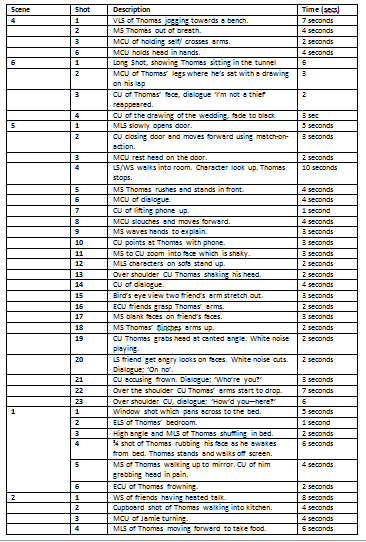
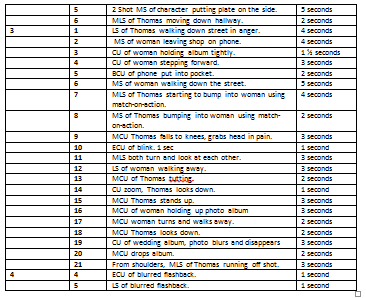


Post 29 - PRE-PRODUCTION: Shot List
Below is the shot list one of our group compiled using the storyboard made earlier. It includes simply details for our shots and is ordered in a way to make it clear to both our cast and crew. The last column with the timing of each shot is very important for us to try and follow.
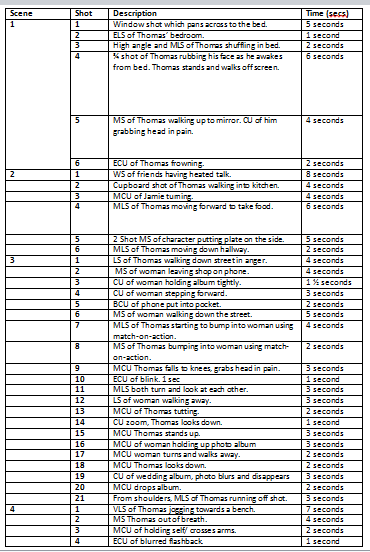



Friday, 22 November 2013
Post 28 - PRE-PRODUCTION: Risk Assessment
RISK ASSESSMENT
 When in members of our group's houses, we had to make sure that any wires from the microphone or personal objects were tucked away to avoid any damage to equipment or members of my group.
When in members of our group's houses, we had to make sure that any wires from the microphone or personal objects were tucked away to avoid any damage to equipment or members of my group.
In the penultimate scene we shot in my own house and because of re-shooting, we had to move around furniture to accommodate the continuity of out film but also to make sure our actors were no harmed. As we filmed before and during the Christmas period, we would have to make sure that when there was a Christmas up, the mechanics of our film worked as followed: Moving the tree away from shot and actors to allow free movement and keeping equipment from the tree to avoid any tangling of wires, the tripod etc.

The outside shots the second scene would pose difficulty, the pathway we are using will be used by the public and we must make sure that the placement of our equipment does not post any threat of harm to the public. We also have to make sure all equipment is in sight at all times and with us to avoid any breaking or stealing of it.
We had to be aware of the fact that the ground was somewhat muddy and using the tripod on the grass for some shots was going to require us to be very careful with the equipment.
Post 27 - PRE-PRODUCTION: Location Reece and Risk Assessment
LOCATION REECE
LOCATION 1 - BEDROOM: For our opening scene we used one of our group's bedrooms as our main character is a student, this worked. We were careful in the room to move our personal stuff and the equipment into a safe area which was away from where we filmed, we opened up the tripod near this however, as shown in the picture.
LOCATION 2 - VILLAGE PATHWAY:After changing our location for Scene 3, during out filming we took these shots. Our location involved a tattoo shop, in which we used the walkway corner to have our female character [Woman] to exit out of. This was done so that we wouldn't need to inconvenience anyone in a shop with multiple takes.
We also used this location because of how open it was for us to position the characters and tripod/camera. This allowed us, whilst there were people using the pathway, to be out of people's way and get out shots done as efficiently as possible. It also limited the risk of damaging the equipment with too many people around us.
LOCATION 3 - KITCHEN: We also filmed inside my house for Scenes 2 and 5, this meant that we had to be careful of both the other members of the household, but also, in such a small space, to make sure the equipment was safe and packed away and any leads were not caught under furniture. In this location we have both natural and artificial lighting as we would be filming after school. This may mean we have to colour correct scenes.
LOCATION 4 - LIVING ROOM: We will only have artifical light within a cramped space and will have to colour correct the scenes. The space in this room will prove difficult because of the size of our shots and the camped space we are shooting in. Some shots will need the reflector in use to make sure our actor's faces are lit up and visable.
Post 26 - PRE-PRODUCTION: Mise-En-Scene Table
Below is the Mise-en-scene table one member of my group produced for our film, it provides the key aspects of each scene which all the cast and crew need to be aware of before filming. We used the template our group used in our AS media but have put more concise detail into it, so it's straight to the point and clear. The importance of this is so no member of the group is confused when looking up what costume they need or what props they need.
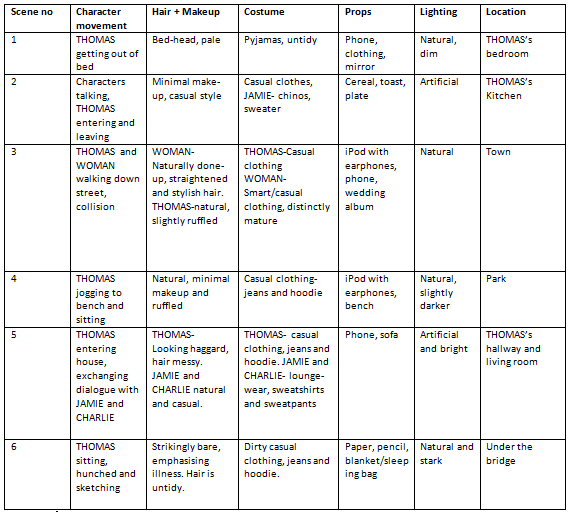
Friday, 15 November 2013
Post 25 - PRE-PRODUCTION: Storyboard
Below are the links to our storyboard, in two PDF files.
https://drive.google.com/file/d/0B8zVTMkwU8ADZnduWnpRdHdNblU/edit?usp=sharing
https://drive.google.com/file/d/0B8zVTMkwU8ADU2ZhM3g4NWpZNTQ/edit?usp=sharing
https://drive.google.com/file/d/0B8zVTMkwU8ADZnduWnpRdHdNblU/edit?usp=sharing
https://drive.google.com/file/d/0B8zVTMkwU8ADU2ZhM3g4NWpZNTQ/edit?usp=sharing
Thursday, 14 November 2013
Post 24 - PRE-PRODUCTION: Script
Two pages of our script.
Thursday, 7 November 2013
Post 23D - Researching our equipment - Camera Tests 2
Birds Eye
Canted Angle
Wednesday, 6 November 2013
Post 23C - Researching our equipment: Camera Tests
Focus
Mirror Shot
Tuesday, 5 November 2013
Post 23B - Researching our equipment - Sound Tests
We preformed two sound tests in our group, one in a classroom using a boom-mic and one in a corridor of our school using a phone to make a sound. We did this because some of our scenes are located in areas where we'll have sound echoes and needed to be aware of how this effects the sound of our actors.
Boom Mic
Corridor
Monday, 4 November 2013
Post 23A - Researching our equipment - Editing Software
In our group, we took the opportunity to play with Adobe After Effects and tutorials from Lynda.com in order to widen out experience with the program and look at things we could do.
This included how we would select a certain area of the shot; how to layer and more special effect related features.
This included how we would select a certain area of the shot; how to layer and more special effect related features.
Sunday, 3 November 2013
Post 22 - Film Distibution
As short films don't have the budget for high-end marketing, film-makers must find other ways in which to promote and show their film. This can be done through multiple platforms, be it social media/digital distribution or film festivals.
Some of the below information is from this booklet we were given by our teacher.
 Websites such as Twitter, Facebook and Tumblr are a great way to spread a film to an audience, word-of-mouth is vital for any film, but especially for short films with a small marketing budget or even none at all. Viral spread is what some film-makers desire and through video websites such as YouTube, short films can be uploaded and views by hundred and thousands of people. This digital distribution is also a away in which short films often find distributors if the film is sent to theatres and cinemas.
Websites such as Twitter, Facebook and Tumblr are a great way to spread a film to an audience, word-of-mouth is vital for any film, but especially for short films with a small marketing budget or even none at all. Viral spread is what some film-makers desire and through video websites such as YouTube, short films can be uploaded and views by hundred and thousands of people. This digital distribution is also a away in which short films often find distributors if the film is sent to theatres and cinemas.
Phone apps such as 'Popcorn Horror' also supply app uses with short films to watch, this spreads an audience further than just the internet, it allows the fragmented audience access to these films offline.
Festivals are a great way to get independent films out to the audience, festivals are also often where both small and larger budget indie films gain distribution for theatrical release, such as Steve McQueen's film 'Shame' which, after the Toronto Film Festival was picked up by 'Fox Searchlight'.
Festivals are a great way for films to win awards, get recognition and find marketing ways to draw in an audience.
The BFI have one of the bigger UK based film festivals every year, which provides a platform for both bigger budget independent films and lower budget films to be submitted into may categories for people to then go and see.
However, most festivals will not allow content that is older than two years to be submitted and thus after these festivals, some films are left to find another way to thrive and reach their audience.
Some of the below information is from this booklet we were given by our teacher.
Social Media
 Websites such as Twitter, Facebook and Tumblr are a great way to spread a film to an audience, word-of-mouth is vital for any film, but especially for short films with a small marketing budget or even none at all. Viral spread is what some film-makers desire and through video websites such as YouTube, short films can be uploaded and views by hundred and thousands of people. This digital distribution is also a away in which short films often find distributors if the film is sent to theatres and cinemas.
Websites such as Twitter, Facebook and Tumblr are a great way to spread a film to an audience, word-of-mouth is vital for any film, but especially for short films with a small marketing budget or even none at all. Viral spread is what some film-makers desire and through video websites such as YouTube, short films can be uploaded and views by hundred and thousands of people. This digital distribution is also a away in which short films often find distributors if the film is sent to theatres and cinemas.Phone apps such as 'Popcorn Horror' also supply app uses with short films to watch, this spreads an audience further than just the internet, it allows the fragmented audience access to these films offline.
Film Festivals
Festivals are a great way for films to win awards, get recognition and find marketing ways to draw in an audience.
The BFI have one of the bigger UK based film festivals every year, which provides a platform for both bigger budget independent films and lower budget films to be submitted into may categories for people to then go and see.
However, most festivals will not allow content that is older than two years to be submitted and thus after these festivals, some films are left to find another way to thrive and reach their audience.
Saturday, 2 November 2013
Post 21 - Film Funding
Short films in general are forgiving in their nature to miss out on character development, be rather simplistic or have short production time, however there is less freedom to expand a universe or flesh out ideas. In relation to film funding, including too much in a film idea, leaving it confusing and sub-par, lowers the chance of a film-maker having their film funded.
 Finding someone to fund your script or finding the money to fund it yourself is a difficult task, film-makers in more recent years can rely on social media outlets and websites such as 'Kickstarter' which is a global project contributing website that helps projects raise the funds they need. Also using social platforms such as Facebook, Twitter, YouTube, film-makers can get their ideas seen to a greater audience than ever before.
Finding someone to fund your script or finding the money to fund it yourself is a difficult task, film-makers in more recent years can rely on social media outlets and websites such as 'Kickstarter' which is a global project contributing website that helps projects raise the funds they need. Also using social platforms such as Facebook, Twitter, YouTube, film-makers can get their ideas seen to a greater audience than ever before.
 Within the UK, the BFI work with the National Lottery provide ways for film-makers to gain funding. This development was done so that the BFI could support film-makers across the UK, through 'film production, distribution, education, audience development and market research'.
Within the UK, the BFI work with the National Lottery provide ways for film-makers to gain funding. This development was done so that the BFI could support film-makers across the UK, through 'film production, distribution, education, audience development and market research'.
 Finding someone to fund your script or finding the money to fund it yourself is a difficult task, film-makers in more recent years can rely on social media outlets and websites such as 'Kickstarter' which is a global project contributing website that helps projects raise the funds they need. Also using social platforms such as Facebook, Twitter, YouTube, film-makers can get their ideas seen to a greater audience than ever before.
Finding someone to fund your script or finding the money to fund it yourself is a difficult task, film-makers in more recent years can rely on social media outlets and websites such as 'Kickstarter' which is a global project contributing website that helps projects raise the funds they need. Also using social platforms such as Facebook, Twitter, YouTube, film-makers can get their ideas seen to a greater audience than ever before.
Subscribe to:
Posts (Atom)

.png)












